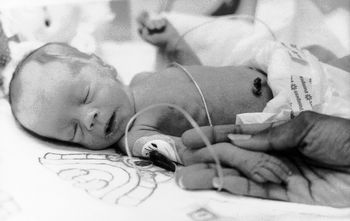Bold approach driving down premature infant mortality rates

An aggressive care approach is helping lower mortality rates for premature babies born at VUH.
An aggressive obstetric approach to accelerate fetal maturity during the hours before pre-term delivery is helping improve the infants' chances of survival, the chief of Vanderbilt Children's Hospital's nurseries says.
Steroid use during pre-term labor, combined with advances in neonatal care, contributed to a mortality rate in the VCH neonatal intensive care unit that is one-fifth the national average, said Dr. William F. Walsh, professor of Pediatrics.
Data from the NICU during 1997 shows that the mortality rate for infants weighing less than 1,500 grams (3 pounds, 5 ounces) was only 5 percent ‹ down from 7 percent in 1996 and 10 percent in 1995, Walsh said.
That compares to a national average of 27 percent.
"Other neonatal centers and groups like the National Institute of Child Health and Development have published rates of around 15 percent, so even among the top neonatal centers, we're doing very well," Walsh said, adding that the trend appears to be continuing through 1998.
Walsh credits collaboration between Vanderbilt obstetricians and neonatologists for the success.
"The obstetricians are doing a good job of getting these babies to us in good shape," Walsh said. "If they can stabilize a woman in labor for a day or two and give her steroids, it helps mature the baby and make the baby more stable.
"The steroids not only mature the lungs in these premature infants, but the brain, the heart, the intestines ‹ the whole organism is just tougher."
VUMC has taken a "considerably more aggressive approach" to the use of antenatal steroids in recent years, including increased usage at Vanderbilt University Hospital and increased education of obstetricians in outlying communities, said Dr. Frank H. Boehm, professor of Obstetrics and Gynecology.
"Our message is 'give steroids, think steroids,'" Boehm said. "We'd really like to be able to administer two doses 48 hours prior to delivery, so time is of the essence."
As more babies born at younger gestational ages survive, more obstetricians are coming to realize that an aggressive approach during pre-term labor is important, Boehm said.
"If you write off a baby because you think it doesn't have a good chance of survival, that becomes a self-fulfilling prophecy," Boehm said. "Today, most physicians believe that by 25 weeks' gestation, a baby has a good chance of surviving and surviving without major long-term morbidity, so they are more likely to be aggressive at trying to improve those chances."
Walsh said that other factors contributing to the NICU's low mortality rate for babies under 1,500 grams include:
o use of surfactant to prevent lung disease;
o extensive use of breast milk for nutrition;
o improved knowledge about the infants' fluid needs;
o development of a gentle mode of ventilation to avoid lung injury.
Also exciting, Walsh said, is that the incidence of long-term disabilities as a result of premature birth and low birthweight does not appear to be increasing as more of these babies survive.
"Not only are we saving more lives, the ones we are saving are generally doing well," he said.
Susan C. DonLevy, R.N., M.S.N., associate in Pediatrics, agreed. DonLevy conducts follow-up assessment of NICU "graduates."
"More and more of these babies are surviving, but the incidence of major neurological handicaps has not increased," she said.
"It is important for us to follow these children through school age. A meta-analysis done in 1991 found that only 10-15 percent of follow-up of these children had gone beyond three years. There's a whole population out there that we can actually study. It's no longer just a few 'miracle babies.' "
Vanderbilt Children's Hospital researchers have collected data at school-age on more than 80 percent of the babies born at VCH who weighed less than 1,000 grams.
"When there is a major neurological concern, it is usually vision impairment, mental retardation or cerebral palsy," DonLevy said. "Even in those that do not have major problems, many children still have a lot of difficulty at school age and some are at risk for academic difficulty.
"But about 30 percent have no handicap at all."
Researchers hope eventually to be able to determine what proportion of those difficulties are due to premature birth and low birthweight, and which are more directly the result of socio-economic factors, DonLevy said.













